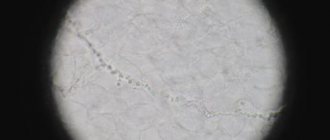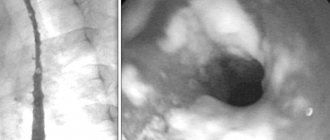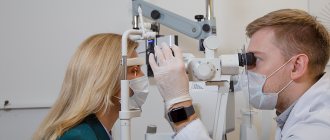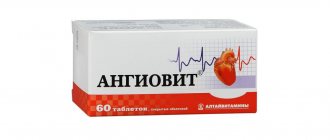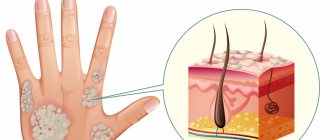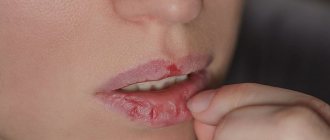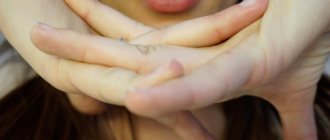You are in the section: Home » Articles » DERMATOLOGY: inguinal athlete's foot (dermatomycosis)
Review
Athlete's foot (also known as tinea inguinalis, eczema fringe, ringworm, Tinea cruris, etc.) is a fungal infection of the trichophytosis class caused by Trichophyton, Microsporum and Epidermophyton fungi that affects the skin of the groin area, including the genitals, inner thighs and buttocks.
Skin lesions manifest themselves in the form of an itchy red, often ring-shaped rash, predominantly located in the warmest and most humid areas of the human body that are constantly covered by clothing. Tinea groin is common in people who sweat a lot, such as athletes. It is also more common in overweight people.
This disease, as a rule, is not serious, although it causes a lot of inconvenience to its carriers. For cure, it is usually sufficient to maintain hygiene of the groin area and use local antifungal drugs.
Symptoms
Fringed eczema usually begins as a red patch of skin that spreads from a crescent-shaped crease in the groin to the upper thigh. The border of the rash may consist of a line of small blisters. The rash often itches or burns, and the skin may peel or become scaly. This, by the way, is where the names groin itching or lichen come from.
When to see a doctor
Call your doctor if you have a skin rash that does not go away on its own within two weeks, or if it appears again within a few weeks of finishing over-the-counter medications.
Causes
Athlete's foot is caused by fungi that can be spread from person to person through direct contact or by sharing contaminated towels or clothing. Tinea cruris in athletes is often caused by the same fungus that infects the feet and causes athlete's foot (Tinea pedis). Usually in these cases the infection is transferred from the foot to the groin folds through the hands or wet towels.
Risk factors
Microorganisms that cause itching in the groin prefer the moist environment of skin folds and hidden places of the human body. Those most at risk are:
- men;
- teenagers or young adults;
- lovers of wearing tight underwear;
- are overweight;
- sweating heavily;
- having a weakened immune system;
- susceptible to diabetes (excessive urination in diabetes insipidus).
Prevention
To reduce your risk of developing athlete's foot, simply follow these principles:
Maintain good body hygiene . It is important to keep the groin area clean and dry. Dry the genital area and inner thighs thoroughly after showering with a clean, ironed towel. To prevent diaper rash, use powder in the groin area.
Wear clean clothes . If you sweat a lot, change your underwear at least once a day or more often. Wash your workout clothes after each use.
Choose clothes that fit . Make sure clothes fit your body, especially underwear and sportswear. Avoid tight-fitting clothing, which can chafe and itch your skin. Try wearing boxer shorts instead of briefs and trunks.
Don't share personal items . Do not allow others to share your clothing, towels, or other personal items. And do not take these items from others yourself.
Treatment of athlete's foot . Control foot infections to prevent them from spreading higher into the groin area. If you frequently visit public places, such as gym showers, public saunas and steam baths, wearing sandals will help prevent athlete's foot infection.
Diagnostics
In most cases, diagnosing tinea groin is not difficult. To determine the disease, simply look at the rash. If the diagnosis is not clear, the doctor may take skin scrapings or samples from the affected area and examine them under a microscope. To rule out other pathologies, your doctor will likely send the sample to a laboratory for culture.
Treatment
For mild tinea groin, your doctor may suggest using an over-the-counter antifungal ointment, lotion, powder, or spray first. With these treatments, the rash may disappear fairly quickly, but you must continue to use the drug as directed for one to two weeks. If tinea pedis is also detected, it is necessary to treat both of these diseases simultaneously. An integrated approach will significantly reduce the risk of relapse.
For severe ringworm or a form of the disease that is resistant to over-the-counter medications, prescription creams or ointments or even antifungal tablets may be needed.
Treatment of severe inguinal athlete's foot, complicated by tinea pedis or other underlying disease, as well as the consequences of self-medication, can take a long time and require a certain amount of patience from the patient. However, it is not incurable and is quite successfully treated by experienced dermatologists at the Clinic of Dr. Filatov.
Causes of irritation in the bikini area
- External factors
Irritation in the bikini area is often caused by mechanical damage to the skin. After shaving the intimate area, redness, pimples, and itching often appear - the skin becomes especially inflamed in the summer, when sweating increases. When depilating with a razor, the top layer of skin is damaged, which can lead to dryness and flaking, and growing short hairs cause itching and, accordingly, redness and scratches on the skin.
Expert opinion
Depilation using wax, sugar paste and tweezers damages the top layer of skin to a lesser extent, but more often provokes ingrown hairs. As a result, painful pimples form in the bikini area, the opening of which is fraught with the penetration of pathogenic agents into the deeper layers of the skin (especially in the hot season).
Obstetrician-gynecologist of the highest category Oksana Anatolyevna Gartleb
Violation of the temperature regime that is comfortable for the skin - too high or, conversely, low temperature - can also cause discomfort in the vagina. Of course, external contamination of delicate areas may not be the last cause of irritation.
In addition, discomfort may occur from inappropriate intimate cosmetics. For example, hypoallergenic baby soap, which many women still use as an intimate care product, greatly dries out the delicate skin of the vagina, since the production of sebum by baby skin and the delicate skin of the intimate area occurs in different volumes. It is important to use special products for intimate hygiene - for example, GINOCOMFORT Soothing washing gel consists of natural ingredients that not only delicately cleanse the vaginal mucosa and skin of the labia, but also regulate the acid-base balance that is comfortable for this area.
- Microflora disturbance
One of the most common causes of severe irritation in the intimate area is diseases associated with disruption of the natural bacterial and acid-base balance: thrush (candidiasis), bacterial vaginosis (dysbacteriosis).
These diseases can be caused by a general decrease in immunity, poor diet, sleep, hygiene, frequent stress, taking antibiotics, promiscuity, etc.
Characteristic symptoms include severe irritation in the intimate area after sex, thick atypical discharge with a pronounced unpleasant odor, severe itching and burning. Any of these diseases is treated with special regimens using antibacterial drugs, pro and prebiotics. Self-medication can cause irreversible complications or make the process critical, so it is better to contact an obstetrician-gynecologist to clarify the diagnosis and develop treatment tactics.
- Allergic reactions
Often, intimate itching can occur with contact dermatitis - a manifestation of allergies in a delicate area. One of the most common reasons is scented hygiene products. Fragrance in pads, tampons, and toilet paper is a strong allergen and can cause itching. If you experience irritation in your intimate area, especially during menstruation, try changing your pads - this may solve your problem. In some cases, allergies can be caused by contraception (latex condoms) and lubricants. Most condoms are made from latex.
- Hormonal background
Irritation in the intimate area in women often occurs before hormonal changes: menstruation, pregnancy. Many women are familiar with the sensation of dryness, burning, and severe itching. Irritation in the perineum can be an external sign of hormonal disorders such as hypo- or hyperfunction of the thyroid gland, ovaries, and adrenal glands. To establish an accurate diagnosis, a consultation with an obstetrician-gynecologist and tests for hormone levels are necessary.
Expert opinion
Changes in hormonal levels and the resulting irritation in the intimate area can be triggered by taking oral contraceptives. This situation is especially common if a woman takes OCs, chosen independently or on the advice of a friend, without consulting a gynecologist.
Obstetrician-gynecologist of the highest category Oksana Anatolyevna Gartleb
- Poor intimate hygiene
It is obvious that irregular showering, especially during menstruation, hot weather or after visiting the gym, leads to an increased proliferation of harmful bacteria and fungi, causing rashes and itching in the intimate area in women. Wearing synthetic underwear also has a negative effect - panties made of artificial fabrics do not allow air to pass through, creating a greenhouse effect - an ideal environment for the proliferation of pathogenic microbes. It is important to know that thongs, thongs and similar models are a “bridge” for bacteria from the anus, so if discomfort occurs, it is better to refrain from wearing them.
- Diseases of internal organs
Endocrinologists warn: severe itching and dryness in the genital area is one of the indirect signs of diabetes. Sometimes irritation in the intimate area can indicate anemia, leukemia, immunodeficiency conditions, inflammation in the urinary system, gastrointestinal tract, and cancer. Redness, spots and rashes on the external genitalia occur with eczema (eczematis) and psoriasis (psoriasis).
Of course, you can’t rely only on vaginal itching to make an accurate diagnosis, but this unpleasant symptom can indicate serious health problems, so it’s better not to delay visiting a specialist.
- Sexual infections
Itching, burning and unpleasant discharge after sexual intercourse (especially unprotected with a new man) are accompanying sexually transmitted diseases. They are especially characteristic of gonorrhea (Gonorrhoea), chlamydia and trichomoniasis (trichomoniasis). In addition to discomfort in the intimate area, sharp pain during urination, pain during sexual intercourse and foul-smelling discharge may be added - if these signs appear, you should urgently get tested and visit an obstetrician-gynecologist. Most sexually transmitted infections in the early stages can be quickly and successfully treated, so timely consultation with a doctor can save you from unpleasant consequences and complications.
- Stress
The female genital organs are very susceptible to psychological conditions: emotional instability, stress and frequent anxiety can cause itching in intimate places.
It is important to monitor your stress levels whenever possible and use sedative therapy if necessary to improve your quality of life.
The causes of irritation in intimate areas are varied and may depend on completely different factors. If you feel that self-treatment does not lead to an improvement in the situation, do not hesitate to visit an obstetrician-gynecologist, this way you will quickly determine the cause of the discomfort and get rid of it.
The causes of irritation in intimate areas are varied and may depend on completely different factors. If you feel that home treatment does not lead to an improvement in the situation, do not hesitate to visit a gynecologist, this way you will quickly determine the cause of the discomfort and get rid of it.
Causes of diaper rash in older people.
The most likely parts of the body to develop diaper rash are:
- Palms;
- Feet;
- Axillary region;
- Groin area.
A problem such as diaper rash (or intertriginous dermatitis) most often manifests itself in skin folds. Constant sweating along with regular friction provokes the appearance of diaper rash. There are also cases when diaper rash in older men and women appears in the intergluteal area. This problem becomes especially relevant in hot summer weather, which causes profuse sweating.
How to get rid of skin irritation in the intimate area?
Of course, only an obstetrician-gynecologist can determine the exact treatment regimen depending on the cause of discomfort. We will tell you about the main methods of relieving itching and burning in intimate areas. In cases associated with diseases of the reproductive organs and other internal diseases, when discomfort in the vagina is a concomitant symptom, complex drug therapy is used to eliminate the underlying cause. It is prescribed individually depending on the underlying disease. In case of endocrine disorders, treatment is carried out using systemic and local hormonal drugs.
Burning and itching due to disturbances in the acid-base balance and microflora are removed with antibacterial or antiseptic drugs, pro and prebiotics, and lactic acid. Treatment often lasts only a few days.
If the discomfort is mild and does not require serious treatment, daily washing with infusions of calendula, arnica, chamomile and other medicinal plants with a calming and disinfecting effect can help.
In the process of eliminating unpleasant sensations in the vagina, it would not be superfluous to enhance the effect of drug treatment from the outside with the help of specialized intimate cosmetics. Soothing washing gel GINOCOMFORT normalizes microflora, gently cleanses the skin and gives a feeling of freshness throughout the day.
How to properly shave the intimate area for women? Source – Ksyu Myakonkaya – Beauty Ksu
Intertriginous dermatitis: forms
- "Widespread." This form of the disease is called seborrheic dermatitis. In cases of this type of disease, diaper rash spreads from the gluteal region to the armpits.
- "Psoriasiform." This type of dermatitis is characterized by peeling skin.
- "Granulomatous". This dermatitis is often caused by a weakened immune system, and it has distinctive features in the form of brown rashes on the skin.
- "Herpetiform." This type of dermatitis is characterized by the appearance of blisters on the body.
Only a qualified dermatologist can diagnose intertriginous dermatitis. When making a diagnosis, a medical professional must conduct a distinctive diagnosis with diseases such as psoriasis, athlete's foot and eczema.
Pimples and irritation after shaving in the intimate area in women: how to properly remove hair with a razor?
Hair removal in intimate areas is a recent trend. How to avoid irritation after depilation?
- Be sure to apply shaving cream or foam to your skin before depilation.
- If you are removing hair with a reusable machine, treat it with a disinfectant such as alcohol or chlorhexidine.
- Use only a very sharp razor; a dull razor can damage delicate skin.
- Do not press the razor too tightly against the skin or run over one area several times in a row.
- After depilation, treat the skin with a septic cream and do not wear underwear until it dries to allow the area to calm down and not cause irritation.
Types and stages of progression of intertriginous dermatitis:
There are three stages of development of this disease: first, second and third.
- At the first stage of diaper rash progression, slight redness of the skin appears.
- The second stage is characterized by the appearance of microcracks and a rash.
- At the third stage of dermatitis, eczema appears.
Contact dermatitis is also a type of diaper rash. This dermatitis has characteristic signs, such as excessive weeping reddish rashes on the skin. This type of disease occurs due to contact with allergic pathogens. The manifestation of dermatitis in the groin area is its second type and is called “impetigo”.
Cream or soap: how to properly care for the skin in intimate places?
- Use only special cosmetics for delicate intimate care. It contains natural ingredients, does not cause allergic reactions and is suitable for gentle cleansing of delicate areas. The composition of GINOCOMFORT washing gels corresponds to modern recommendations of gynecologists - GINOCOMFORT intimate cosmetics are not only suitable for daily care, but also help to maintain the cleanliness of the genitals during menstruation and during the treatment of gynecological diseases, when the body is especially vulnerable.
- If possible, wear comfortable underwear made from natural fabrics. If you want to wear erotic panties, be sure to take a shower before putting on such panties, and also change your underwear before going to bed - sleeping in thongs can increase the level of pathogenic bacteria in the vagina.
- Maintain personal hygiene: obstetricians-gynecologists recommend washing yourself 1-2 times a day, during menstruation up to 4 times a day, if possible, with each pad change.
Pads and tampons should be changed every 3-4 hours, regardless of the amount of discharge. - Pay attention to contraception: if you are allergic to latex, choose condoms made from other materials.
- Visit your obstetrician-gynecologist at least 2 times a year to rule out the development of diseases.
And remember: irritation in the intimate area, even if it just “itches” and there are no other more serious symptoms, is not the norm, and this condition is most often easy to eliminate.
There is no need to avoid the possibility of solving an unpleasant problem. The right cosmetics and treatment selected by an obstetrician-gynecologist will allow you to regain confidence in your beauty, comfort, feeling of freshness and good mood every day. Sources:
- Inflammatory diseases of the female genital organs. Modern perinatal technologies in strengthening the reproductive health of patients. Naumov I.A. // Monograph. Saarbrucken: LAP LAMBERT Academic Publishing GmbH end Co. KG. — 2011. — pp. 18–21.
- Microbiological characteristics of biotopes of the reproductive tract with endometritis. Glukhova E.V., Shakhovskaya I.N. // Togliatti honey. consultation – 2008. – 1 (2): pp. 38–44.
- Medical and social characteristics and forecasting of reproductive health of young women at the present stage. Torubarov S.F. // Social aspects of public health. – 2013. – 5 (33): P. 7.
- https://ciplamed.com/content/important-tips-to-maintain-intimate-hygiene
- https://www.lactacyd.eu/your-intimate-zone/
- https://www.medicalnewstoday.com/articles/321537.php
Ointments for diaper rash
Using specialized ointments is a very effective way to combat skin rashes.
- "Zinc ointment". This pharmacological agent is excellent for the treatment of diaper rash. It dries and softens the skin, thereby helping to reduce fluid discharge from wounds.
- "Bepanten." It is a very common remedy for rashes. This pharmacological drug accelerates wound healing. This product is available in the form of cream and ointment.
- "Nystatin" This is an antibiotic that comes in the form of an ointment. It is recommended by many dermatologists. It has an antifungal effect and delays the development of infectious fungi.
- "Salicylic ointment." This drug quickly relieves skin redness and inflammatory processes.
- "Salicylic-zinc paste." It was recognized by doctors as a very effective remedy. It helps dry wounds, eliminates redness, and helps exfoliate dead tissue.
Popular questions
Irritation on the pubic area under the hair.
What to do? You need to understand what caused this: an allergic reaction, a bacterial, fungal or viral infection, or an injury during depilation. For this, a consultation with an obstetrician-gynecologist, and in some cases a dermatologist, is required. Only then will it be possible to recommend suitable treatment.
Severe itching on the labia, irritation. There is nothing to worry about in the vagina itself. What could it be?
This may result in an allergic reaction or inflammation. I recommend using Ginocomfort gel with mallow extract, applying it once a day to the discomfort zone for 7 days. If you do not notice relief, consult a doctor.
I am 69 years old. I am concerned about vaginal irritation and dryness. I was treated once with Triozhinal suppositories. The result was positive for 1.5 years. Now this problem has arisen again. But now these candles cause a strong burning sensation. Today I am flying to the sea, and I am afraid that I will not be able to swim, since the salt water is making the problem worse. Please advise what I can do. Thank you! Hello! During the postmenopausal period, inflammatory processes develop in the genital tract against the background of atrophic changes in the mucosa caused by hormone deficiency. Its layers become thinner, elasticity decreases, and the number of lactobacilli decreases. In this situation, a study is required: a smear for flora, oncocytology. The first step is to prescribe drugs with anti-inflammatory activity, and the second step is to moisturize, restore microflora, and, in the absence of contraindications, local hormone-containing suppositories. A feature of treatment in this age group is continuous maintenance therapy. At this stage, before receiving the results of the study, you can use Ginocomfort gel with mallow extract, which will have anti-inflammatory and moisturizing effects. The gel is applied in 1 dose 1 time per day for 10-14 days.
Hello! Is it possible to feel a burning sensation and irritation when using Gynocomfort?
Hello!
A slight tingling sensation may be felt immediately after administration, but will quickly subside on its own. If this happens, then you should continue to use the gel. For an accurate diagnosis, contact a specialist
Methods for treating diaper rash.
Treatment of diaper rash in elderly people can be carried out using both medications and folk remedies.
Healthcare providers recommend prioritizing the use of pharmacological agents that can treat the underlying cause of intertriginous dermatitis.
One of the methods of treating diaper rash in an elderly person is the use of manganese. Having made a weak solution of manganese with water, you need to use it to wipe the affected skin.
At this time, there are some difficulties with purchasing potassium permanganate; in this case, furatsilin can be used instead . Furacilin is an antimicrobial drug and is intended for external use. This drug is sold in two forms: solution and tablets. To treat diaper rash, it would be better to choose a liquid solution of furatsilin, this is the most convenient option for use. The duration of such treatment is from 5 to 7 days.
The most suitable for the treatment of dermatitis, which manifests itself in women in the form of diaper rash under the mammary glands, are lotions made from a solution of copper sulfates or a solution of zinc.
Specialists at the private home for the elderly "Edem" in Moscow and the Moscow region use only proven means for the prevention and treatment of diaper rash.
Traditional methods of treating diaper rash.
You can treat manifestations of dermatitis in elderly women using an iodine solution: 1 drop of iodine per 200 grams of water. The affected skin is washed with this solution, then wiped with a soft cloth to dry. After using this method, it is not advisable to immediately put on clothes - you need to wait at least 10-15 minutes.
When using these methods, it is necessary to take into account concomitant diseases (Alzheimer's disease, Parkinson's disease, dementia, etc.) so as not to cause harm.
It is also necessary to do lotions on a regular basis. Eucalyptus is great for this. After preparing two tablespoons of eucalyptus leaves, place them in 200 ml. water and heat in a water bath for 7 minutes. Then wet a cotton napkin with this decoction and apply it to the damaged area for 15-20 minutes.
